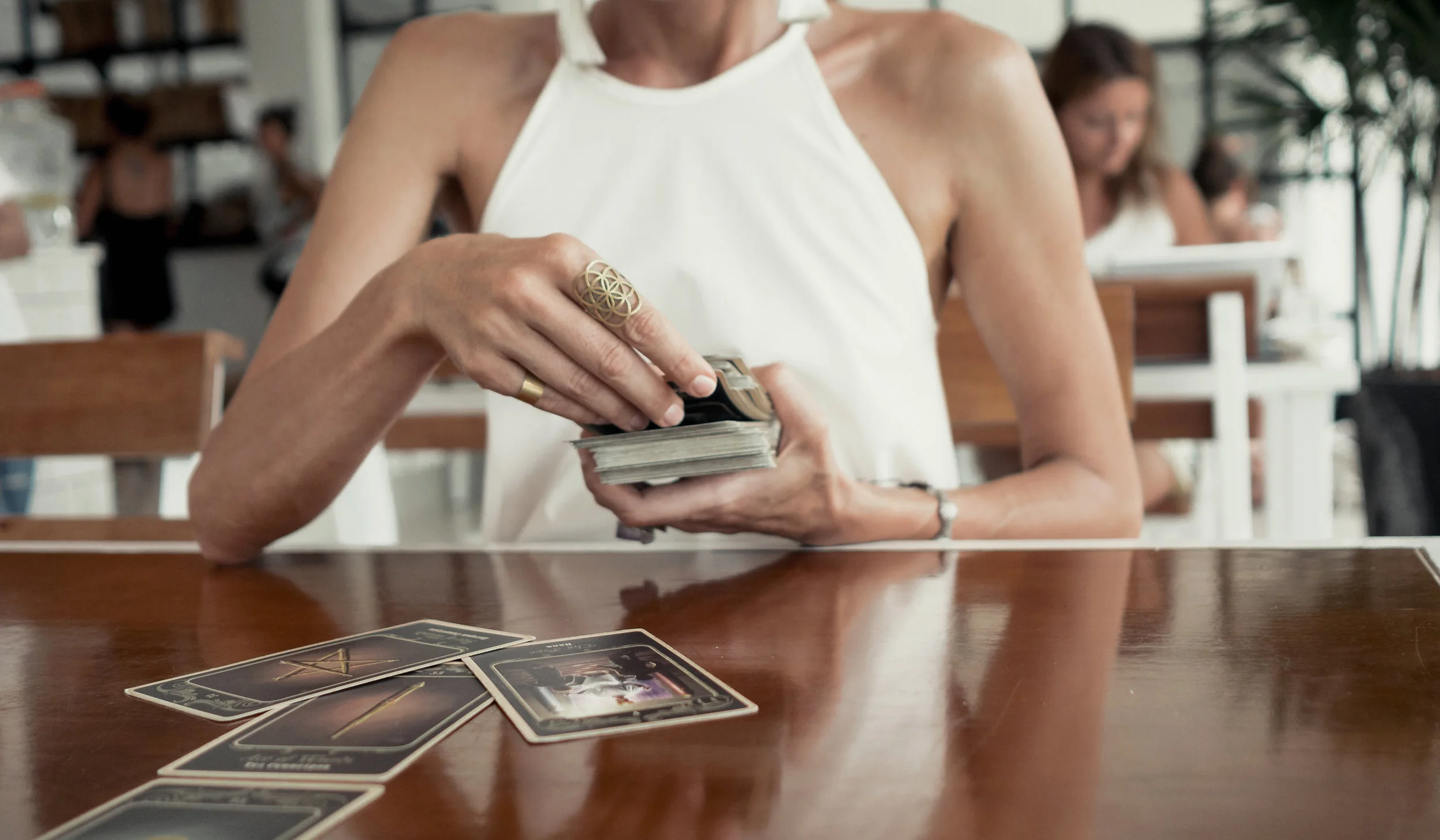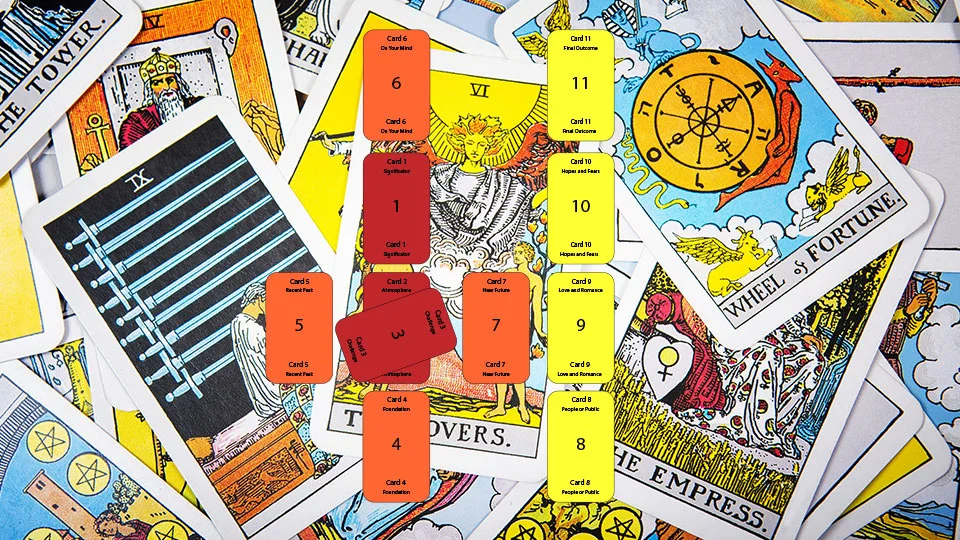Five Techniques for Reading Larger Tarot Spreads
Five Techniques for Reading Larger Tarot Spreads
Here are five techniques to help you get the most out of larger tarot spreads.
I am a fan of large tarot spreads. I would much rather read eleven cards than three, five, seven or nine. Sometimes I think this puts me in a minority amongst my tarot peers, and I wonder why that is.
I think it may be that people feel that fewer cards can mean less confusion, and that more cards make a reading more complicated. For me, the opposite is true. For me, more cards mean more information, and more information means more clarity.
It also seems that some readers develop enough skill to handle a specific reading style, and then stop growing in their skill development. Very often these same readers quickly lose enthusiasm for their work with tarot. I’ve often wondered if the process of learning new skills and techniques might keep newer tarotists more happily engaged.
What follows is a list of my favorite techniques for working with larger tarot spreads. Many of these techniques can be combined in the same tarot reading session. Beware becoming the reader who handles a spread the same way each time. The more techniques you know, the more valuable tarot will become to you.
The Card by Card Method
To read a spread card-by-card, simply begin with the first position, say the name of the position, say the name of the card that appears there, and then interpret the card in the context of the position.
Very often you can use the name or description of the position in your interpretation to help get the context right. For example, if the Hermit were to fall in a ‘crossing’ position – that is, a position that denotes a problem or obstacle, you might say, “It looks as though your biggest problem right now is loneliness.”
The Card-by-Card Method is extremely helpful if you don’t get an immediate hit on the spread as soon as you lay it out. If the cards feel confusing, blah or contradictory, the Card-by-Card Method can help you make sense of the reading.
Card Trends and Groupings
Very often we can derive a huge amount of information from a spread by reading the cards in groups. Card grouping can happen as part of a spread, where the spread instructs you to read certain positions as a group. Card grouping can happen in a spread where there are multiple positions with similar meanings, like positions for ‘Future’ and ‘Final Outcome’.
We can also group cards together when we have multiples of number or rank, or numeric runs within suits. These numeric groups can often reveal a story or important message. For example, multiple Knights may speak of travel, or encourage the querent to pursue their goals. If the Eight, Nine and Ten of Swords appear, there may be a story about negative self-talk or chronic mental health issues.
If three cards of the name number appear, it is helpful to think about the one that is missing and interpret the reason it isn’t present. For example, if your client receives all the Aces except the Ace of Cups, it might be time to have a conversation about what is possible and desirable in the romantic aspect of life at this time.
When a suit is predominating or missing in a spread you can derive information from that. Likewise, when there is a predominance of Major Arcana cards, or reversed cards.
Look, as well, for cards that are natural opposites or corroborators. For example, if the Four and Six of Pentacles both appear, there is some push-and-pull in terms of how many resources can be given away. If the Two of Cups and Four of Wands appear together, there may be a very blessed romantic union at hand.
Thinking about which cards share common keywords can be helpful in performing these kinds of readings. When you see a number of cards in a spread that speak of education, or balance, or travel, or communication, you can get a sense of an overall theme or area of concern.
Start with What Pops Out
When you lay out your tarot spread, you may be pulled to talk about a specific card first. It may or may not be a Major Arcana card, or a particularly strong energy card, or a particularly pivotal position.
To use this method, simply talk about what you see first. What pulls at your psychically, or visually? What do you see that makes you curious?
Once you begin speaking about the first thing you see, you will naturally start to include the other cards as the story unfolds.
With this method you don’t necessarily need to mention the cards by name or describe their symbolism or keywords. You can simply say what you see, based on one, or a few, of the cards that strike you first and hardest.
This method is very good for opening up your own intuition and psychic flow and allowing the cards to speak.
It’s important, however, to make sure that what you are seeing is matching your client’s understanding and experience. If it’s not, you need to ascertain where the disconnect is coming from. Are you interpreting the cards inappropriately for the context? Is the client not understanding the wording you are using? Are you and the client seeing the same thing but perceiving it differently?
You can check in with the client regularly to make sure you are on track by saying things like “Does that make sense to you? Or “Do you see it that way?”
As long as you are able to stay on the same page as your client, the Start with What Pops Out method can really allow your reading to take on its own life.
Make a List
Sometimes you look at a spread and all you see is a bunch of cards. Nothing comes together or pops out at you right away. When this happens, don’t panic! Simply make a list of the energies you see in the cards and start with that. You can present it this way. “Here’s a list of some of the things that are striking me, in no particular order of importance.”
You will find that as you begin your list of seemingly unrelated energies, people and events they will begin to tell a story and make sense to you. By beginning with a simple list you can, over the course of the reading, build the complex story.
Use Smaller Spreads and Single Cards to Answer Questions
Very often a larger, comprehensive spread ends up asking more questions than in answers. You might see that your client has some problems with their job, but the spread may not offer a solution. You might see that your client is likely to enter a new romantic relationship soon, but want more information about what that will look like.
Typically, after I get as much information as I can from a large spread, I will pick up all the cards, shuffle them, and then ask questions one by one, pulling a card, or a few cards, or doing small spreads to answer those questions.
What? You might ask, Even more cards? What’s up with that?
Not all cards speak with the same weight. In any reading, some cards will give a great deal of information, others will just corroborate, or offer an adjective or adverb. The more cards we use, the more possibilities we can see, the more nuance we can understand, and the more helpful information we can derive.
Christiana’s Eleven-Card Celtic Cross on Card and Craft Academy!
Learn my favorite comprehensive spread and some great techniques for reading larger tarot spreads with this fun and easy video class.

